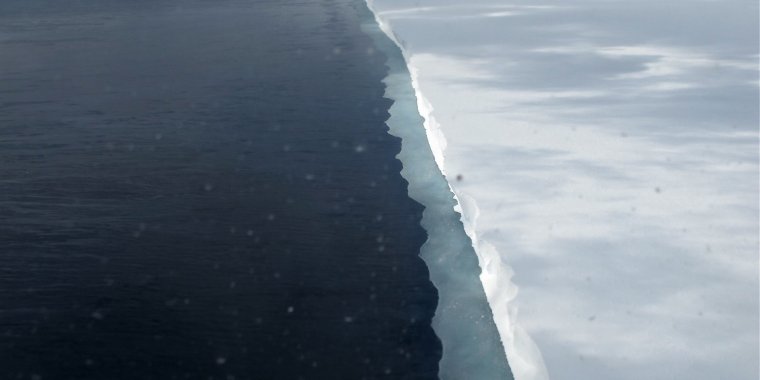| News / Science News |
Rapid melting of the world’s largest ice shelf linked to solar heat in the ocean
In a study of Antarctica’s Ross Ice Shelf, which covers an area roughly the size of France, the scientists spent several years building up a record of how the north-west sector of this vast ice shelf interacts with the ocean beneath it. Their results show that the ice is melting much more rapidly than previously thought due to inflowing warm water.

Edge of the Ross Ice Shelf seen from the NASA P-3 on the return flight from McMurdo Station on Nov. 28, 2013. Photo: NASA/Jim Yungel
Although the interactions between ice and ocean occurring hundreds of metres below the surface of ice shelves seem remote, they have a direct impact on long-term sea level. The Ross Ice Shelf stabilises the West Antarctic ice sheet by blocking the ice which flows into it from some of the world’s largest glaciers.
Data from the instruments deployed on the mooring showed that solar heated surface water flows into the cavity under the ice shelf near Ross Island, causing melt rates to nearly triple during the summer months.
The melting is affected by a large area of open ocean in front of the ice shelf that is empty of sea ice due to strong offshore winds. This area, known as the Ross Sea Polynya, absorbs solar heat quickly in summer and this solar heat source is clearly influencing melting in the ice shelf cavity.
The findings suggest that conditions in the ice shelf cavity are more closely coupled with the surface ocean and atmosphere than previously assumed, implying that melt rates near the ice front will respond quickly to changes in the uppermost layer of the ocean.
The potential for increasing melt rates in this region has implications for ice shelf stability due to the shape of the ice shelf. Rapid melting identified by the study happens beneath a thin and structurally important part of the ice shelf, where the ice pushes against Ross Island. Pressure from the island, transmitted through this region, slows the flow of the entire ice shelf.
While the Ross Ice Shelf is considered to be relatively stable, the new findings show that it may be more vulnerable than thought so far. The point of vulnerability lies in the fact that that solar heated surface water flows into the cavity near a stabilising pinning point, which could be undermined if basal melting intensifies further.
The study shows that melting in this specific region is 10 times higher than the average melt rate expected for the ice shelf as a whole.
The researchers point out that melting measured by the study does not imply that the ice shelf is currently unstable. The ice shelf has evolved over time and ice lost by melting due to inflow of warm water is roughly balanced by the inputs of ice from feeding glaciers and snow accumulation.
This balance is, however, depending on the stability provided by the Ross Island pinning point, which the new study identifies as a point of future vulnerability.
YOU MAY ALSO LIKE



